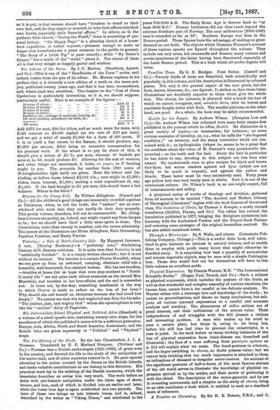The Labour of the Farm. By J. C. Morton. (Bradbury,
Agnew, and Co.)—This is one of the " Handbooks of the Farm " series, and, indeed, comes from the pen of its editor. Mr. Morton explains in his preface that it is virtually a new edition of a work on the same sub- ject, published twenty years ago, and that it has been reconsidered, and, where need was, rewritten. The chapter on the " Cost of Farm Operations is particularly interesting, as it is, we should suppose, particularly useful. Here is an example of the figures
£108 15 ... 162 0 ... 100 0 50 acres of clover.... _
Snarler, carriage vie., carage of =tennis, fencing,
100 acre, pasture, attendance on stock, ... 103 0 300 acres. L.603
Add £375 for rent, £80 for tithes, and as much more for rates, with £150 interest on £3,000 capital (at the rate of £1.0 per acre), and we get a total of nearly £1,300 for a farm of 300 acres. If it is to yield a fair return to the farmer, it should produce, say, £1,600 per annum, £300 being no excessive remuneration for his personal work. If the wheat is to pay its share of this, it should give a return of £5 7s. per sore, whereas 40 bushels per sore at 4s. 6d. would produce £9. Allowing for the cost of manure, and other things not mentioned, it looks, on paper, as if farming ought to pay. The accounts for another farm (930 acres of Nottinghamshire light land) are given. Here the labour cost (in- cluding, as before, horse labour) £2,042 10s. ; rent might be £1,300 ; tithes, rates, interest, £1,000; making a total expenditure of, say, £5,400. If the land brought in £6 per acre, this should leave a fair balance. Where is the hitch?


















































 Previous page
Previous page